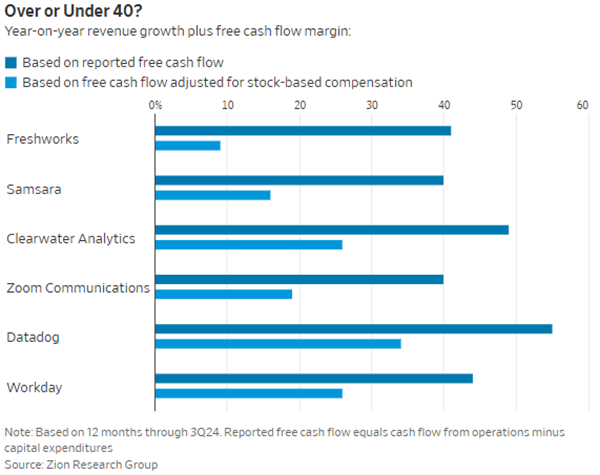The Stock Market Is Like a Fashion Show, and Here’s One of Its Hot
Must-Haves
Software companies are touting something called the ‘Rule of 40,’
but some are more flash than substance
By
Jonathan Weil
Jan. 3, 2025 6:00 am ET
|

Whatever
numbers investors want to see, management will supply them. Photo: H.
Armstrong Roberts/ClassicStock/Getty Images
|
Like hemlines and haircuts, stocks go in and out of fashion. So do the
ways companies communicate their performance to investors. Whatever
numbers investors want to see, management will supply them, especially
if they can be easily tailored to look flattering.
For so-called SaaS
companies, selling software as
a service, a favorite metric nowadays is something called the “Rule of
40.” The first thing to know is it isn’t a rule, because there is no
standard definition for what it means. For some companies it has
become a big deal to claim membership in the “Rule of 40 club”
nonetheless.
In general the rule holds that a company’s revenue growth plus its
profit margin should be 40% or greater. So if a company has 20%
revenue growth and a 20% margin, it gets to be in the club. Same for
40% growth and no margin, or 30% growth and a 10% margin.
Brad Feld, a venture-capital investor,
popularized this notion with a blog post back in 2015 called “The
Rule of 40% For a Healthy SaaS Company.”
The term’s first appearance in a company’s Securities and Exchange
Commission filing was in 2017, going by the results of a database
search on the SEC’s website. A
2021 study by McKinsey, the
consulting giant, is credited for helping spread its usage and showed
that the market rewarded companies with higher valuations if they are
at or above the Rule of 40.
|

Brad Feld
in New York in 2011. Photo: Peter Foley/Bloomberg
Photo: Peter Foley/Bloomberg
|
Here is where it starts to fall apart: While revenue has a standard
meaning, there is no consensus on which measure of profit companies
should use to calculate the margin component. Should it be operating
income? Net income? Cash flow? Maybe some nonstandard version of
earnings or cash flow? The numbers that companies are showing lack
comparability because they aren’t apples-to-apples, and the companies
often don’t show their math.
But say everyone could agree on a particular margin metric to use for
the calculation. The traditional one that McKinsey recommended was
free cash flow. This typically is defined as operating cash flow,
which has a standard definition, minus capital expenditures. Even
then, the metric’s usefulness starts to crumble. Done this way, the
rule favors companies that rely heavily on stock-based compensation to
pay their employees, while punishing those that don’t and instead pay
more heavily in cash. That is because free cash flow, like operating
cash flow, excludes stock-based pay, which is a real cost that counts
in companies’ reported profits.
David Zion, founder of Zion Research Group
and a longtime accounting and tax analyst, in a December research
note did his own Rule of 40
calculations for North American application-software companies with
stock-market values of greater than $1 billion. For this exercise, he
took the sum of revenue growth plus free-cash-flow margin using the
last reported four quarters. Of the 98 companies in the group, 33 of
them met or beat the Rule of 40. However, when he adjusted free cash
flow to treat stock-based pay as an expense, only 11 companies still
met or beat the Rule of 40 under both methods. They included Palantir
Technologies and Constellation
Software.
|

|
At Freshworks,
for instance, during the company’s recent earnings call, Chief
Executive Dennis Woodside said, “adding our revenue growth and
free-cash-flow margin for Q3, we exceeded the Rule of 40 in the
quarter.” Indeed, Zion calculated that its Rule of 40 number was 41%,
which put Freshworks at No. 29 on his ranking out of the 98 companies.
Revenue growth was just over 20%, and so was free-cash-flow margin.
But when Zion adjusted Freshworks’ margin figure to treat stock-based
pay as an expense, its Rule of 40 number fell to 9% and its ranking
dropped to No. 76. The reason: Its stock-based pay exceeded its free
cash flow. In other words, if that compensation had been paid in cash
instead of stock, Freshworks’ free cash flow would have been negative,
and its free-cash-flow margin would have been negative 11%.
Similarly, Workday’s chief
executive, Carl Eschenbach, at an investor conference in May said
“we’re a Rule of 40 company.” Using free-cash-flow margin for the
calculation, Zion showed its Rule of 40 number was 44% for the past
four quarters, but it was 26% if stock-based compensation was treated
as an expense.
Write to Jonathan Weil at jonathan.weil@wsj.com